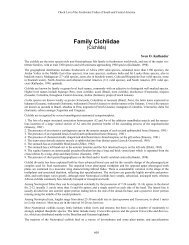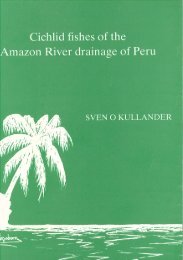Open Access PDF - Sven Kullander
Open Access PDF - Sven Kullander
Open Access PDF - Sven Kullander
You also want an ePaper? Increase the reach of your titles
YUMPU automatically turns print PDFs into web optimized ePapers that Google loves.
314<br />
material is 220 mm, but he figures a large adult,<br />
360 mm, with three distinct ocelli on the side, and<br />
lists a 617 mm specimen from the Sección de<br />
Osteologia del Aquarium Agustín Codazzi (no<br />
number, not listed in Machado-Allison, 1973: 158)<br />
in table 2. Machado-Allison (1973: 158) lists 6<br />
skeletal preparations 215-334 mm SL. Since the<br />
617 mm specimen is the only specimen in that<br />
paper stated to possess a continuous lateral line<br />
and an elevated number of lateral line scales (97,<br />
vs. upper + lower lateral line 73-88 recorded for<br />
other C. orinocensis in that paper), the identification<br />
is recorded here with reservation.<br />
Williams et al. (1998: 178) reported specimens<br />
up to 56.5 cm TL (corresponding to ca 46 cm SL)<br />
from the Guri reservoir, but their figure of size<br />
distributions (fig. 2) shows a specimen in the<br />
interval 65-70 cm TL. Winemiller (2001: 98) reported<br />
C. orinocensis up to 455 mm SL in rivers<br />
and 550 mm SL in reservoirs.<br />
Cichla orinocensis can be distinguished from<br />
all other Cichla species by the adult colour pattern,<br />
which typically includes three prominent black,<br />
ocellated blotches on the side, but no additional<br />
blotches on the dorsum (Fig. 15). The ocellated<br />
blotches develop gradually and directly from dark<br />
blotches along the midline of the side, and vary<br />
considerably in appearance in adults (Figs. 15-19).<br />
This variation is well covered by Román (1981),<br />
with illustrations of “typical” individuals with<br />
distinct ocelli (pp. 19, 27, 36, 49, 53, 70, 73, 105,<br />
113, 122, and 129), varying with respect to the<br />
background colour pattern, and both including<br />
specimens with golden or silvery specks on the<br />
black blotches and specimens with pure black<br />
blotches. An adult with an additional prominent<br />
ocellus between blotches 1 and 2 is illustrated by<br />
Román (1981: 74).<br />
Cichla orinocensis never shows black blotches<br />
posterior to the pectoral-fin base as in C. ocellaris,<br />
C. monoculus, C. kelberi, or C. pleiozona.<br />
Juvenile and young C. orinocensis up to 60-<br />
70 mm are similar to juvenile and young C. monoculus,<br />
C. kelberi and C. ocellaris in colour pattern.<br />
Both C. monoculus and C. orinocensis possess a<br />
wide, prominent dark band connecting the bar 3<br />
blotch and the caudal base blotch; in C. ocellaris<br />
this band is relatively more narrow and lighter.<br />
With increasing fish size, the caudal peduncle<br />
band disappears in all three species, but the bar<br />
3 blotch transforms differently: in C. orinocensis<br />
the bar 3 blotch (like the bar 1-2 blotches) develops<br />
into an ocellated midaxis blotch; in C. monocu-<br />
lus and C. kelberi lateral blotches are replaced by<br />
vertical bars which more intensely pigmented<br />
dorsally and the caudal peduncle band disappears;<br />
in C. ocellaris the bar 3 blotch remains as<br />
an irregular dark blotch unlike the bar 2 and 3<br />
blotches which are replaced by bars.<br />
Adults of the sympatric species C. temensis<br />
can be separated by scale counts (E1 scales 75-89<br />
in C. orinocensis vs. 98-128), absence of lateral<br />
ocelli, and postorbital markings wide vs. reduced<br />
to a few small blotches in C. orinocensis. Juveniles<br />
of C. temensis, in which scale counts are difficult<br />
to obtain, possess a continuous lateral band vs.<br />
distinct blotches 1 and 3, and a band caudad from<br />
blotch 3.<br />
Although C. orinocensis has a fairly wide distribution<br />
including two major drainage basins,<br />
there is no obvious geographical correlate in the<br />
variation in morphometric or meristic characters<br />
and the colour pattern variation cannot be organised<br />
geographically.<br />
A small specimen, MBUCV-V 10287, 82.3 mm<br />
SL, from the Venezuelan part of the Rio Cuyuni<br />
(Fig. 20), departs in colour pattern from young<br />
C. ocellaris, possessing an ocellated blotch 1, a<br />
large caudad tapering blotch 3, and the caudal<br />
blotch expanded onto the caudal peduncle. This<br />
colour pattern agrees with that illustrated by<br />
Eigenmann (1912, pl. 69 fig. 2) of a 138 mm<br />
specimen from Gluck Island in the Essequibo<br />
River identified by Eigenmann as C. ocellaris.<br />
Eigenmann’s other figures of a juvenile and two<br />
adults of Guyanan C. ocellaris are compatible with<br />
C. ocellaris as illustrated in this paper and in <strong>Kullander</strong><br />
& Nijssen (1989). The Cuyuni specimen<br />
has 80 scales in the E1 row and lateral line sinistrally<br />
discontinuous, dextrally continuous. Measurements<br />
fall outside C. ocellaris in morphometric<br />
PCA analyses. The colour pattern is more similar<br />
to that of small C. orinocensis (cf. Fig. 13), although<br />
the blotches may be considered large also for that<br />
species. A photograph of a large adult Cichla<br />
specimen, MCNG 16565, 225 mm SL, from the<br />
Rio Cuyuni (specimen not examined; photograph<br />
reproduced by Winemiller, 2001: fig. 1, right<br />
center, as C. ocellaris), shows a specimen very<br />
similar to a large specimen of C. orinocensis from<br />
the Rio Caroní (Fig. 18). It is thus possible that a<br />
population of C. orinocensis inhabits the upper Rio<br />
Cuyuni and the possible presence of this species<br />
in the Essequibo River drainage, suggested by<br />
Eigenmann’s figure, should be investigated further.<br />
<strong>Kullander</strong> & Ferreira: Review of Cichla




